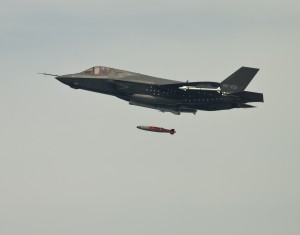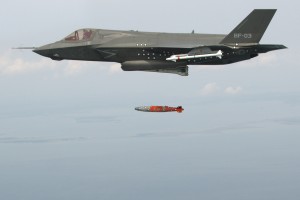2012-08-09 This Fall, the first F-35B squadron will be set up and getting ready for operations in 2013. This squadron will be stood up at the Yuma Air Station in Arizona.
According to a Lockheed press release:
The F-35 Lightning II accomplished a significant test milestone Aug. 8 when the aircraft successfully released a weapon in flight.
Traveling at 400 knots at an altitude of 4,200 ft, BF-3, a short take-off and vertical landing F-35 variant, released an inert 1,000 lb. GBU-32 Joint Direct Attack Munition (JDAM) separation weapon over water in an Atlantic test range.
“While this weapons separation test is just one event in a series of hundreds of flights and thousands of test points that we are executing this year, it does represent a significant entry into a new phase of testing for the F-35 program,” said Navy Capt. Erik Etz, director of test for F-35 naval variants. “Today’s release of a JDAM was the result of extraordinary effort by our team of maintainers, engineers, pilots and others that are consistently working long hours to deliver F-35 warfighting capability to the U.S. services and our international partners.”
The release was the first time for any version of the F-35 to conduct an airborne weapon separation, as well as the first from an internal weapons bay for a fighter aircraft designated for the U.S. Marine Corps, the United Kingdom and Italy.
The milestone marks the start of validating the F-35’s capability to employ precision weapons and allow pilots to engage the enemy on the ground and in the air.
“[Using an internal weapons bay] speaks to how much capability the JSF is going to bring to the troops,” said Dan Levin, Lockheed Martin test pilot for the mission. “Stealth, fifth generation avionics, and precision weapons … coupled with the flexible mission capability of the short take-off and vertical landing F-3 5B is going to be huge for our warfighters.”
An aerial weapons separation test checks for proper release of the weapon from its carriage system and trajectory away from the aircraft. It is the culmination of a significant number of prerequisite tests, including ground fit checks, ground pit drops and aerial captive carriage and environment flights to ensure the system is working properly before expanding the test envelope in the air.
Aircraft and land-based test monitoring systems collected data from the successful separation which is in review at the F-35 integrated test force at Naval Air Station Patuxent River.
For a USMC perspective on the F-35B and its approach to deployment, please see the presentation made by a senior USMC officer at the Heritage Foundation conference on the F-35 and Allies.
https://www.sldinfo.com/a-marine-corps-perspective-on-the-f-35-getting-on-with-it/



